Marketing Management Report: Starbucks and Marketing Planning Analysis
VerifiedAdded on 2023/01/10
|32
|9163
|82
Report
AI Summary
This report provides a comprehensive analysis of marketing management principles, focusing on the strategic planning and implementation within a business context. It begins by examining the crucial role of mission statements in guiding marketing strategies, with a detailed analysis of Starbucks' mission statement to illustrate key criteria and its impact on marketing planning. The report then delves into market analysis, evaluating tools like SWOT and PESTLE to understand the external and internal environments. It explores the relationship between marketing strategy, market analysis, goals, and actions, using Starbucks as a case study for market positioning, segmentation, and competitive analysis. Furthermore, the report discusses the implementation of the marketing mix (product, price, promotion, and place) and concludes with a discussion of marketing strategies across commercial, non-profit, and public sectors, including the evaluation of marketing's impact on social and political change. The report provides a detailed overview of the strategic marketing planning, market analysis, and the marketing mix, as well as the role of marketing in different sectors.
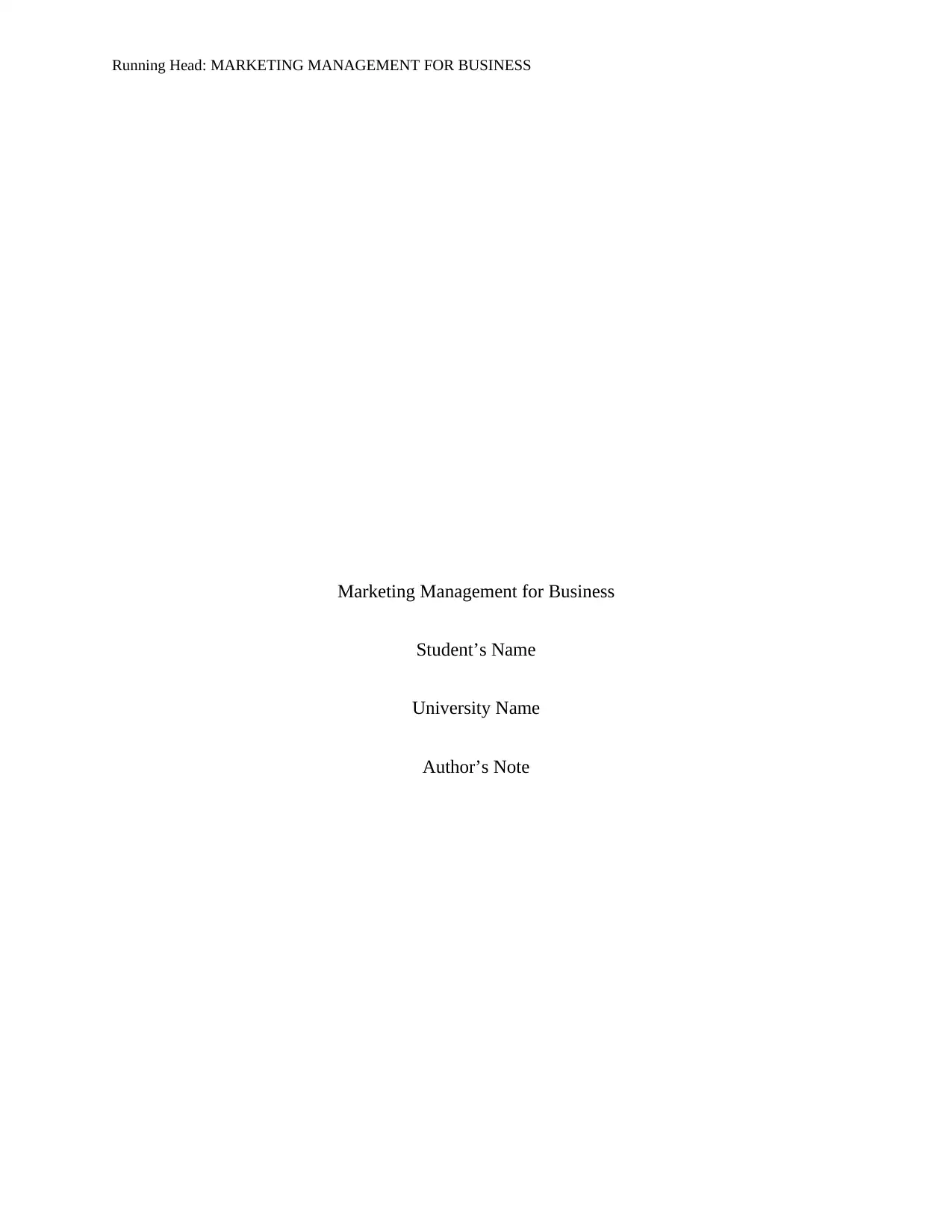
Running Head: MARKETING MANAGEMENT FOR BUSINESS
Marketing Management for Business
Student’s Name
University Name
Author’s Note
Marketing Management for Business
Student’s Name
University Name
Author’s Note
Paraphrase This Document
Need a fresh take? Get an instant paraphrase of this document with our AI Paraphraser
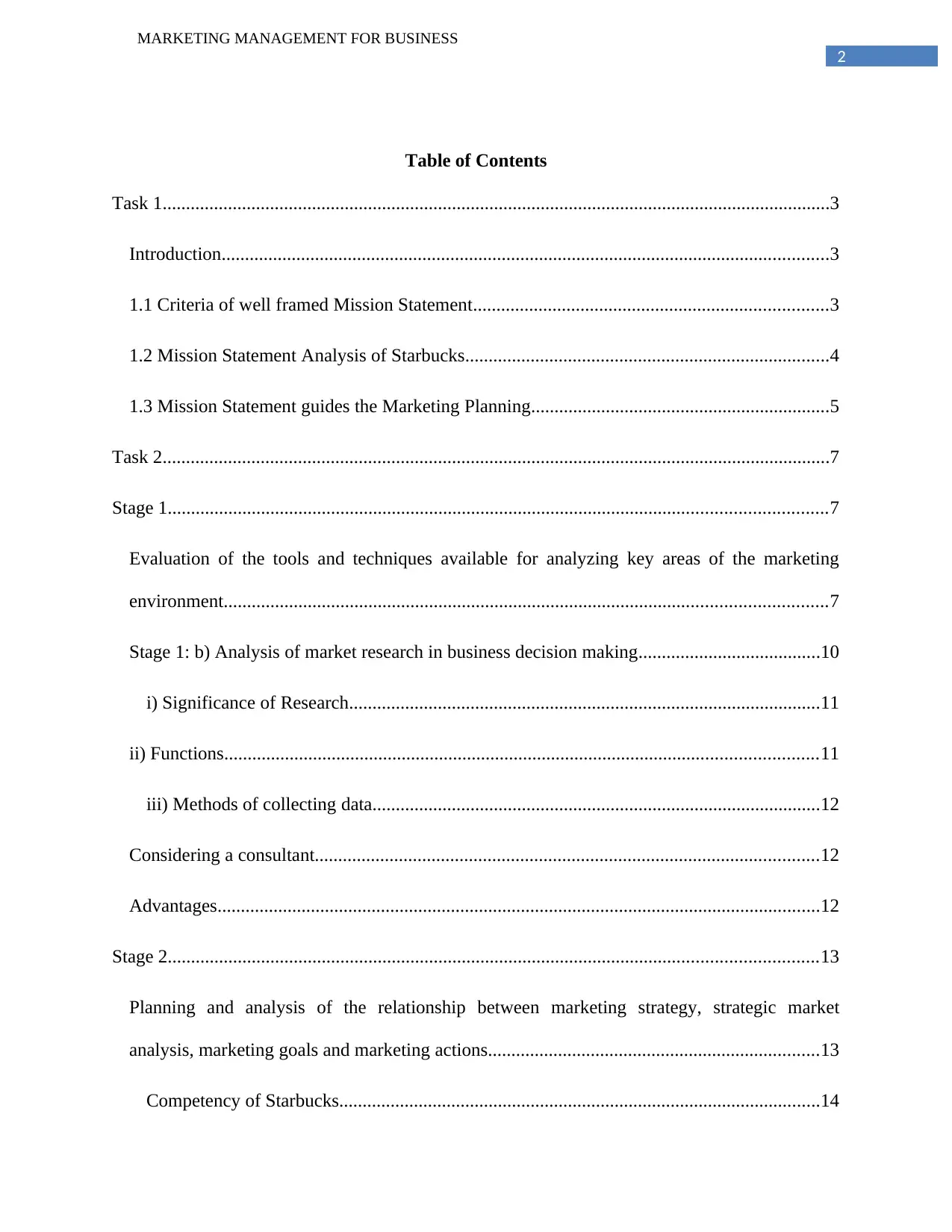
2
MARKETING MANAGEMENT FOR BUSINESS
Table of Contents
Task 1...............................................................................................................................................3
Introduction..................................................................................................................................3
1.1 Criteria of well framed Mission Statement............................................................................3
1.2 Mission Statement Analysis of Starbucks..............................................................................4
1.3 Mission Statement guides the Marketing Planning................................................................5
Task 2...............................................................................................................................................7
Stage 1.............................................................................................................................................7
Evaluation of the tools and techniques available for analyzing key areas of the marketing
environment.................................................................................................................................7
Stage 1: b) Analysis of market research in business decision making.......................................10
i) Significance of Research.....................................................................................................11
ii) Functions...............................................................................................................................11
iii) Methods of collecting data................................................................................................12
Considering a consultant............................................................................................................12
Advantages.................................................................................................................................12
Stage 2...........................................................................................................................................13
Planning and analysis of the relationship between marketing strategy, strategic market
analysis, marketing goals and marketing actions.......................................................................13
Competency of Starbucks.......................................................................................................14
MARKETING MANAGEMENT FOR BUSINESS
Table of Contents
Task 1...............................................................................................................................................3
Introduction..................................................................................................................................3
1.1 Criteria of well framed Mission Statement............................................................................3
1.2 Mission Statement Analysis of Starbucks..............................................................................4
1.3 Mission Statement guides the Marketing Planning................................................................5
Task 2...............................................................................................................................................7
Stage 1.............................................................................................................................................7
Evaluation of the tools and techniques available for analyzing key areas of the marketing
environment.................................................................................................................................7
Stage 1: b) Analysis of market research in business decision making.......................................10
i) Significance of Research.....................................................................................................11
ii) Functions...............................................................................................................................11
iii) Methods of collecting data................................................................................................12
Considering a consultant............................................................................................................12
Advantages.................................................................................................................................12
Stage 2...........................................................................................................................................13
Planning and analysis of the relationship between marketing strategy, strategic market
analysis, marketing goals and marketing actions.......................................................................13
Competency of Starbucks.......................................................................................................14
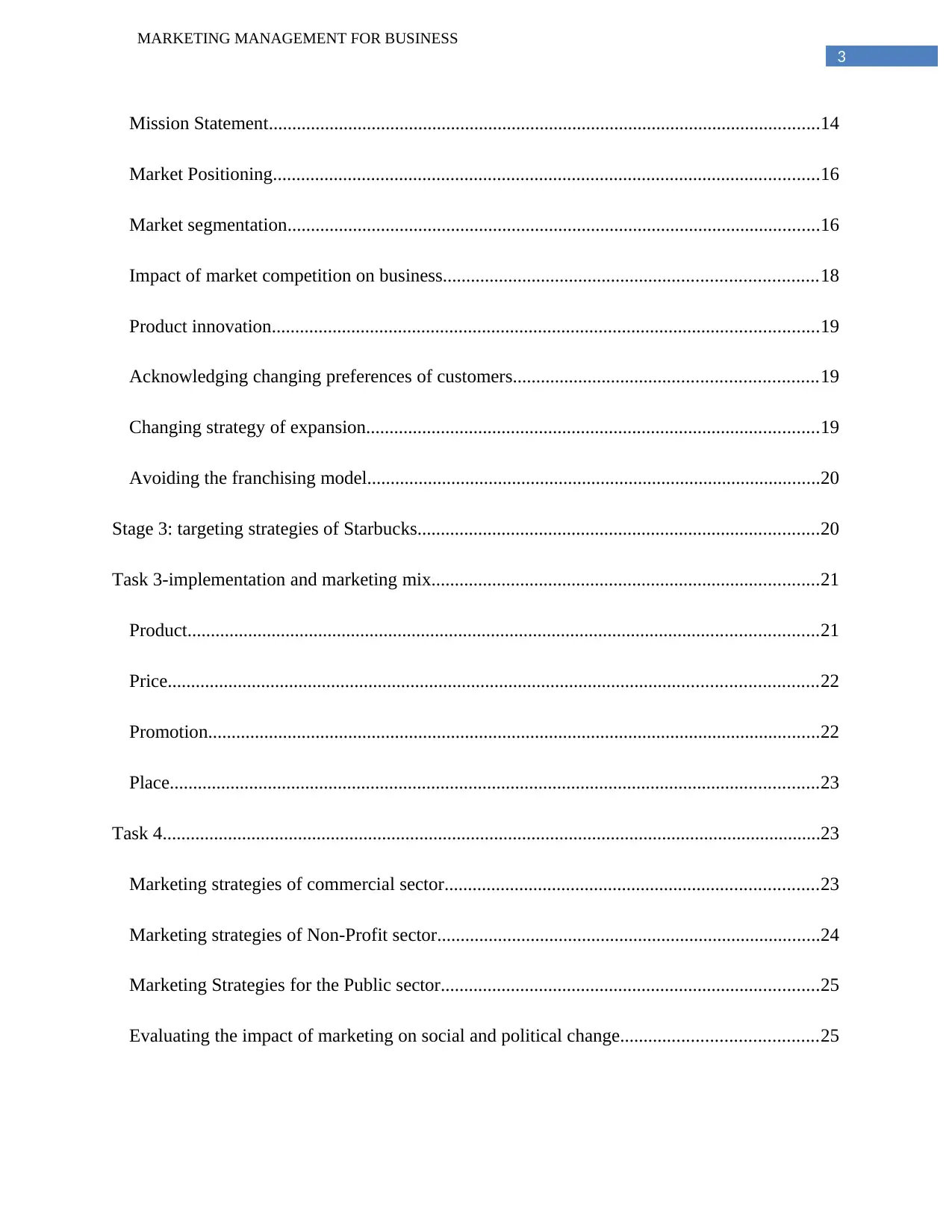
3
MARKETING MANAGEMENT FOR BUSINESS
Mission Statement......................................................................................................................14
Market Positioning.....................................................................................................................16
Market segmentation..................................................................................................................16
Impact of market competition on business................................................................................18
Product innovation.....................................................................................................................19
Acknowledging changing preferences of customers.................................................................19
Changing strategy of expansion.................................................................................................19
Avoiding the franchising model.................................................................................................20
Stage 3: targeting strategies of Starbucks......................................................................................20
Task 3-implementation and marketing mix...................................................................................21
Product.......................................................................................................................................21
Price...........................................................................................................................................22
Promotion...................................................................................................................................22
Place...........................................................................................................................................23
Task 4.............................................................................................................................................23
Marketing strategies of commercial sector................................................................................23
Marketing strategies of Non-Profit sector..................................................................................24
Marketing Strategies for the Public sector.................................................................................25
Evaluating the impact of marketing on social and political change..........................................25
MARKETING MANAGEMENT FOR BUSINESS
Mission Statement......................................................................................................................14
Market Positioning.....................................................................................................................16
Market segmentation..................................................................................................................16
Impact of market competition on business................................................................................18
Product innovation.....................................................................................................................19
Acknowledging changing preferences of customers.................................................................19
Changing strategy of expansion.................................................................................................19
Avoiding the franchising model.................................................................................................20
Stage 3: targeting strategies of Starbucks......................................................................................20
Task 3-implementation and marketing mix...................................................................................21
Product.......................................................................................................................................21
Price...........................................................................................................................................22
Promotion...................................................................................................................................22
Place...........................................................................................................................................23
Task 4.............................................................................................................................................23
Marketing strategies of commercial sector................................................................................23
Marketing strategies of Non-Profit sector..................................................................................24
Marketing Strategies for the Public sector.................................................................................25
Evaluating the impact of marketing on social and political change..........................................25
⊘ This is a preview!⊘
Do you want full access?
Subscribe today to unlock all pages.

Trusted by 1+ million students worldwide
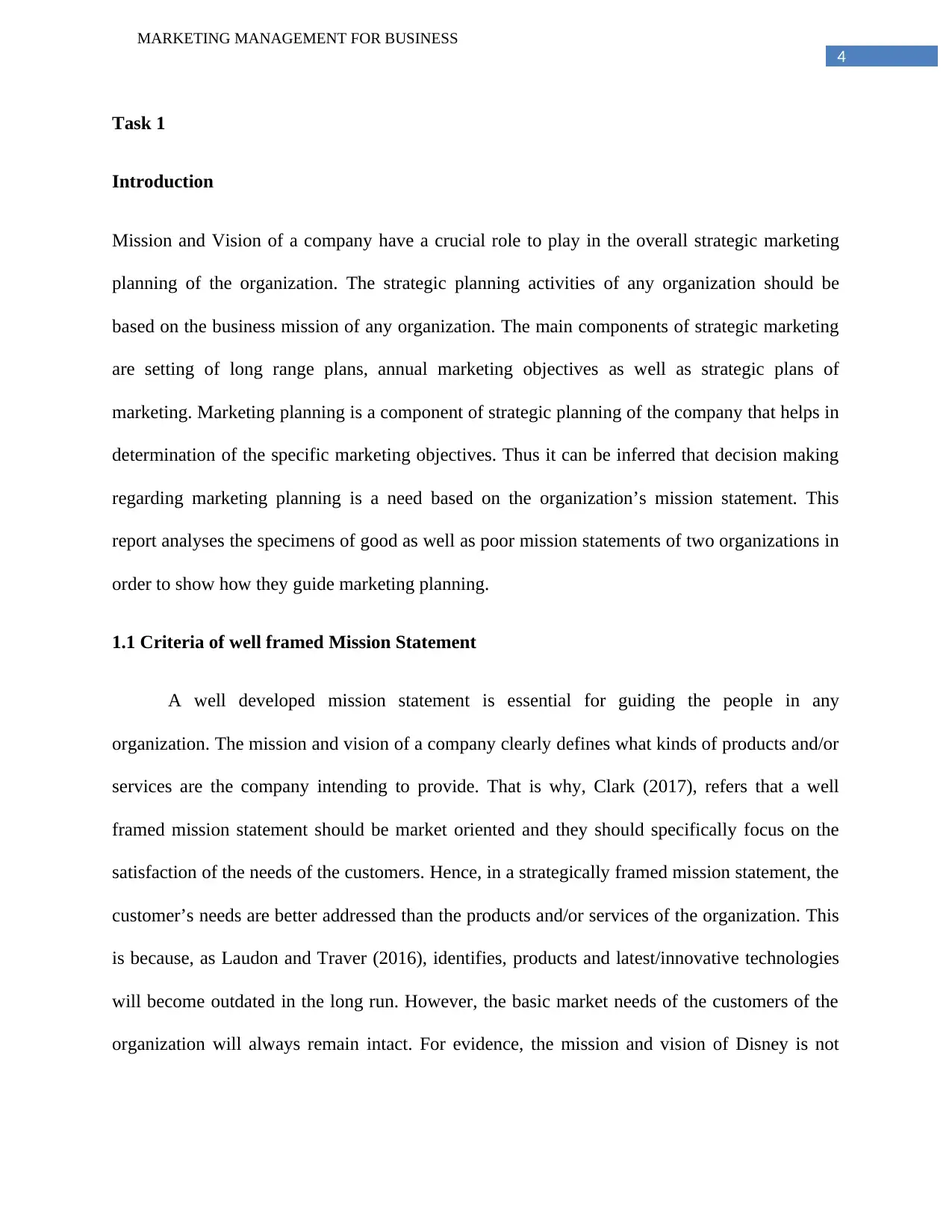
4
MARKETING MANAGEMENT FOR BUSINESS
Task 1
Introduction
Mission and Vision of a company have a crucial role to play in the overall strategic marketing
planning of the organization. The strategic planning activities of any organization should be
based on the business mission of any organization. The main components of strategic marketing
are setting of long range plans, annual marketing objectives as well as strategic plans of
marketing. Marketing planning is a component of strategic planning of the company that helps in
determination of the specific marketing objectives. Thus it can be inferred that decision making
regarding marketing planning is a need based on the organization’s mission statement. This
report analyses the specimens of good as well as poor mission statements of two organizations in
order to show how they guide marketing planning.
1.1 Criteria of well framed Mission Statement
A well developed mission statement is essential for guiding the people in any
organization. The mission and vision of a company clearly defines what kinds of products and/or
services are the company intending to provide. That is why, Clark (2017), refers that a well
framed mission statement should be market oriented and they should specifically focus on the
satisfaction of the needs of the customers. Hence, in a strategically framed mission statement, the
customer’s needs are better addressed than the products and/or services of the organization. This
is because, as Laudon and Traver (2016), identifies, products and latest/innovative technologies
will become outdated in the long run. However, the basic market needs of the customers of the
organization will always remain intact. For evidence, the mission and vision of Disney is not
MARKETING MANAGEMENT FOR BUSINESS
Task 1
Introduction
Mission and Vision of a company have a crucial role to play in the overall strategic marketing
planning of the organization. The strategic planning activities of any organization should be
based on the business mission of any organization. The main components of strategic marketing
are setting of long range plans, annual marketing objectives as well as strategic plans of
marketing. Marketing planning is a component of strategic planning of the company that helps in
determination of the specific marketing objectives. Thus it can be inferred that decision making
regarding marketing planning is a need based on the organization’s mission statement. This
report analyses the specimens of good as well as poor mission statements of two organizations in
order to show how they guide marketing planning.
1.1 Criteria of well framed Mission Statement
A well developed mission statement is essential for guiding the people in any
organization. The mission and vision of a company clearly defines what kinds of products and/or
services are the company intending to provide. That is why, Clark (2017), refers that a well
framed mission statement should be market oriented and they should specifically focus on the
satisfaction of the needs of the customers. Hence, in a strategically framed mission statement, the
customer’s needs are better addressed than the products and/or services of the organization. This
is because, as Laudon and Traver (2016), identifies, products and latest/innovative technologies
will become outdated in the long run. However, the basic market needs of the customers of the
organization will always remain intact. For evidence, the mission and vision of Disney is not
Paraphrase This Document
Need a fresh take? Get an instant paraphrase of this document with our AI Paraphraser
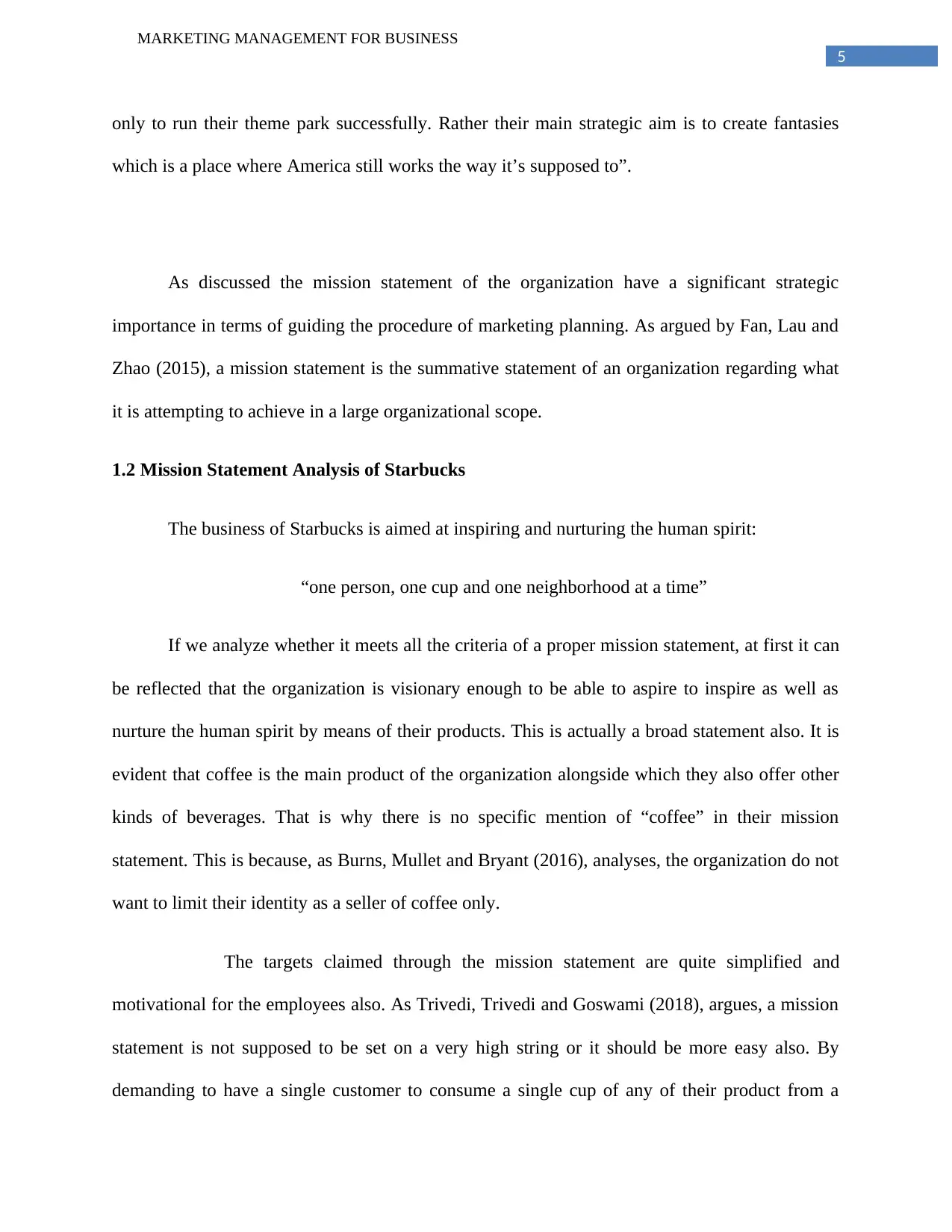
5
MARKETING MANAGEMENT FOR BUSINESS
only to run their theme park successfully. Rather their main strategic aim is to create fantasies
which is a place where America still works the way it’s supposed to”.
As discussed the mission statement of the organization have a significant strategic
importance in terms of guiding the procedure of marketing planning. As argued by Fan, Lau and
Zhao (2015), a mission statement is the summative statement of an organization regarding what
it is attempting to achieve in a large organizational scope.
1.2 Mission Statement Analysis of Starbucks
The business of Starbucks is aimed at inspiring and nurturing the human spirit:
“one person, one cup and one neighborhood at a time”
If we analyze whether it meets all the criteria of a proper mission statement, at first it can
be reflected that the organization is visionary enough to be able to aspire to inspire as well as
nurture the human spirit by means of their products. This is actually a broad statement also. It is
evident that coffee is the main product of the organization alongside which they also offer other
kinds of beverages. That is why there is no specific mention of “coffee” in their mission
statement. This is because, as Burns, Mullet and Bryant (2016), analyses, the organization do not
want to limit their identity as a seller of coffee only.
The targets claimed through the mission statement are quite simplified and
motivational for the employees also. As Trivedi, Trivedi and Goswami (2018), argues, a mission
statement is not supposed to be set on a very high string or it should be more easy also. By
demanding to have a single customer to consume a single cup of any of their product from a
MARKETING MANAGEMENT FOR BUSINESS
only to run their theme park successfully. Rather their main strategic aim is to create fantasies
which is a place where America still works the way it’s supposed to”.
As discussed the mission statement of the organization have a significant strategic
importance in terms of guiding the procedure of marketing planning. As argued by Fan, Lau and
Zhao (2015), a mission statement is the summative statement of an organization regarding what
it is attempting to achieve in a large organizational scope.
1.2 Mission Statement Analysis of Starbucks
The business of Starbucks is aimed at inspiring and nurturing the human spirit:
“one person, one cup and one neighborhood at a time”
If we analyze whether it meets all the criteria of a proper mission statement, at first it can
be reflected that the organization is visionary enough to be able to aspire to inspire as well as
nurture the human spirit by means of their products. This is actually a broad statement also. It is
evident that coffee is the main product of the organization alongside which they also offer other
kinds of beverages. That is why there is no specific mention of “coffee” in their mission
statement. This is because, as Burns, Mullet and Bryant (2016), analyses, the organization do not
want to limit their identity as a seller of coffee only.
The targets claimed through the mission statement are quite simplified and
motivational for the employees also. As Trivedi, Trivedi and Goswami (2018), argues, a mission
statement is not supposed to be set on a very high string or it should be more easy also. By
demanding to have a single customer to consume a single cup of any of their product from a
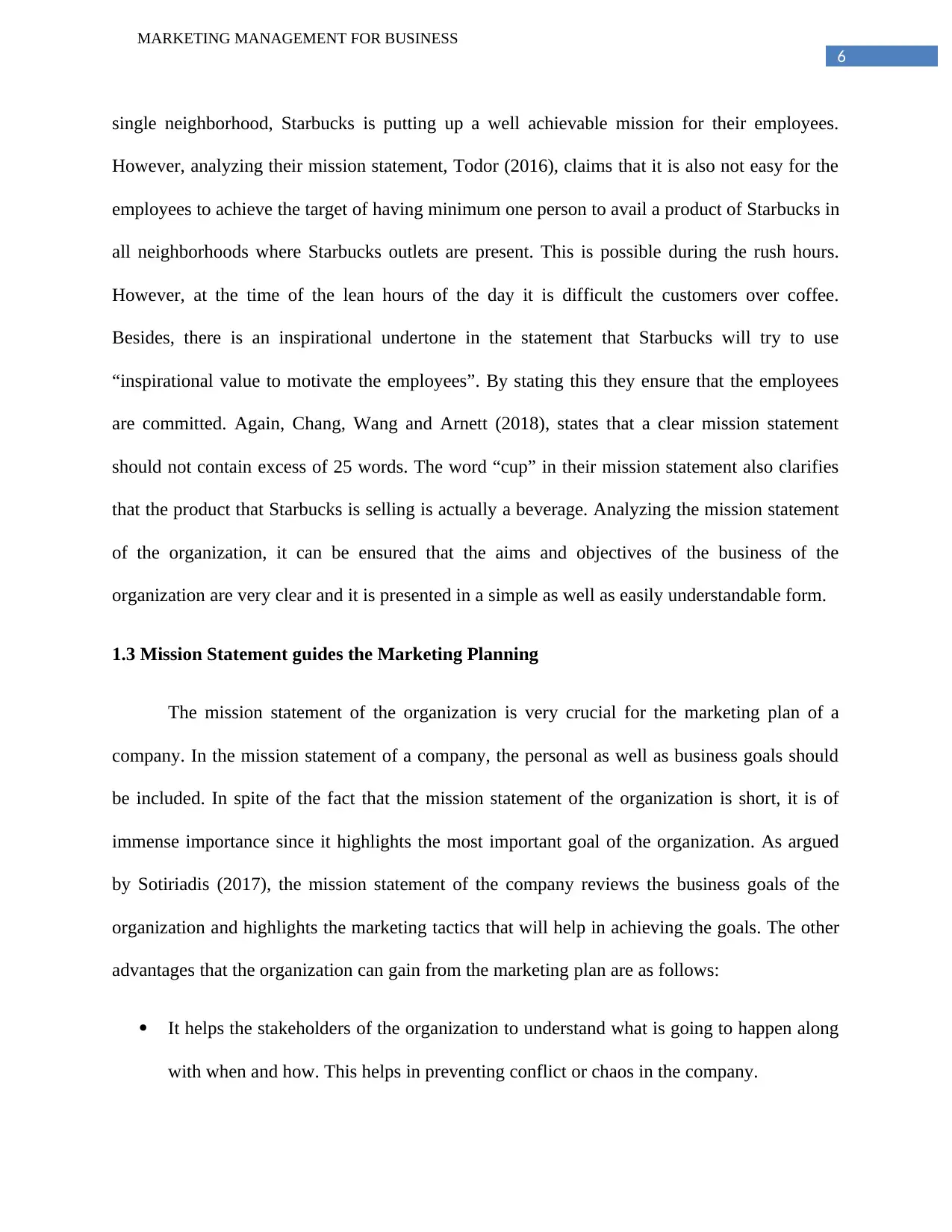
6
MARKETING MANAGEMENT FOR BUSINESS
single neighborhood, Starbucks is putting up a well achievable mission for their employees.
However, analyzing their mission statement, Todor (2016), claims that it is also not easy for the
employees to achieve the target of having minimum one person to avail a product of Starbucks in
all neighborhoods where Starbucks outlets are present. This is possible during the rush hours.
However, at the time of the lean hours of the day it is difficult the customers over coffee.
Besides, there is an inspirational undertone in the statement that Starbucks will try to use
“inspirational value to motivate the employees”. By stating this they ensure that the employees
are committed. Again, Chang, Wang and Arnett (2018), states that a clear mission statement
should not contain excess of 25 words. The word “cup” in their mission statement also clarifies
that the product that Starbucks is selling is actually a beverage. Analyzing the mission statement
of the organization, it can be ensured that the aims and objectives of the business of the
organization are very clear and it is presented in a simple as well as easily understandable form.
1.3 Mission Statement guides the Marketing Planning
The mission statement of the organization is very crucial for the marketing plan of a
company. In the mission statement of a company, the personal as well as business goals should
be included. In spite of the fact that the mission statement of the organization is short, it is of
immense importance since it highlights the most important goal of the organization. As argued
by Sotiriadis (2017), the mission statement of the company reviews the business goals of the
organization and highlights the marketing tactics that will help in achieving the goals. The other
advantages that the organization can gain from the marketing plan are as follows:
It helps the stakeholders of the organization to understand what is going to happen along
with when and how. This helps in preventing conflict or chaos in the company.
MARKETING MANAGEMENT FOR BUSINESS
single neighborhood, Starbucks is putting up a well achievable mission for their employees.
However, analyzing their mission statement, Todor (2016), claims that it is also not easy for the
employees to achieve the target of having minimum one person to avail a product of Starbucks in
all neighborhoods where Starbucks outlets are present. This is possible during the rush hours.
However, at the time of the lean hours of the day it is difficult the customers over coffee.
Besides, there is an inspirational undertone in the statement that Starbucks will try to use
“inspirational value to motivate the employees”. By stating this they ensure that the employees
are committed. Again, Chang, Wang and Arnett (2018), states that a clear mission statement
should not contain excess of 25 words. The word “cup” in their mission statement also clarifies
that the product that Starbucks is selling is actually a beverage. Analyzing the mission statement
of the organization, it can be ensured that the aims and objectives of the business of the
organization are very clear and it is presented in a simple as well as easily understandable form.
1.3 Mission Statement guides the Marketing Planning
The mission statement of the organization is very crucial for the marketing plan of a
company. In the mission statement of a company, the personal as well as business goals should
be included. In spite of the fact that the mission statement of the organization is short, it is of
immense importance since it highlights the most important goal of the organization. As argued
by Sotiriadis (2017), the mission statement of the company reviews the business goals of the
organization and highlights the marketing tactics that will help in achieving the goals. The other
advantages that the organization can gain from the marketing plan are as follows:
It helps the stakeholders of the organization to understand what is going to happen along
with when and how. This helps in preventing conflict or chaos in the company.
⊘ This is a preview!⊘
Do you want full access?
Subscribe today to unlock all pages.

Trusted by 1+ million students worldwide
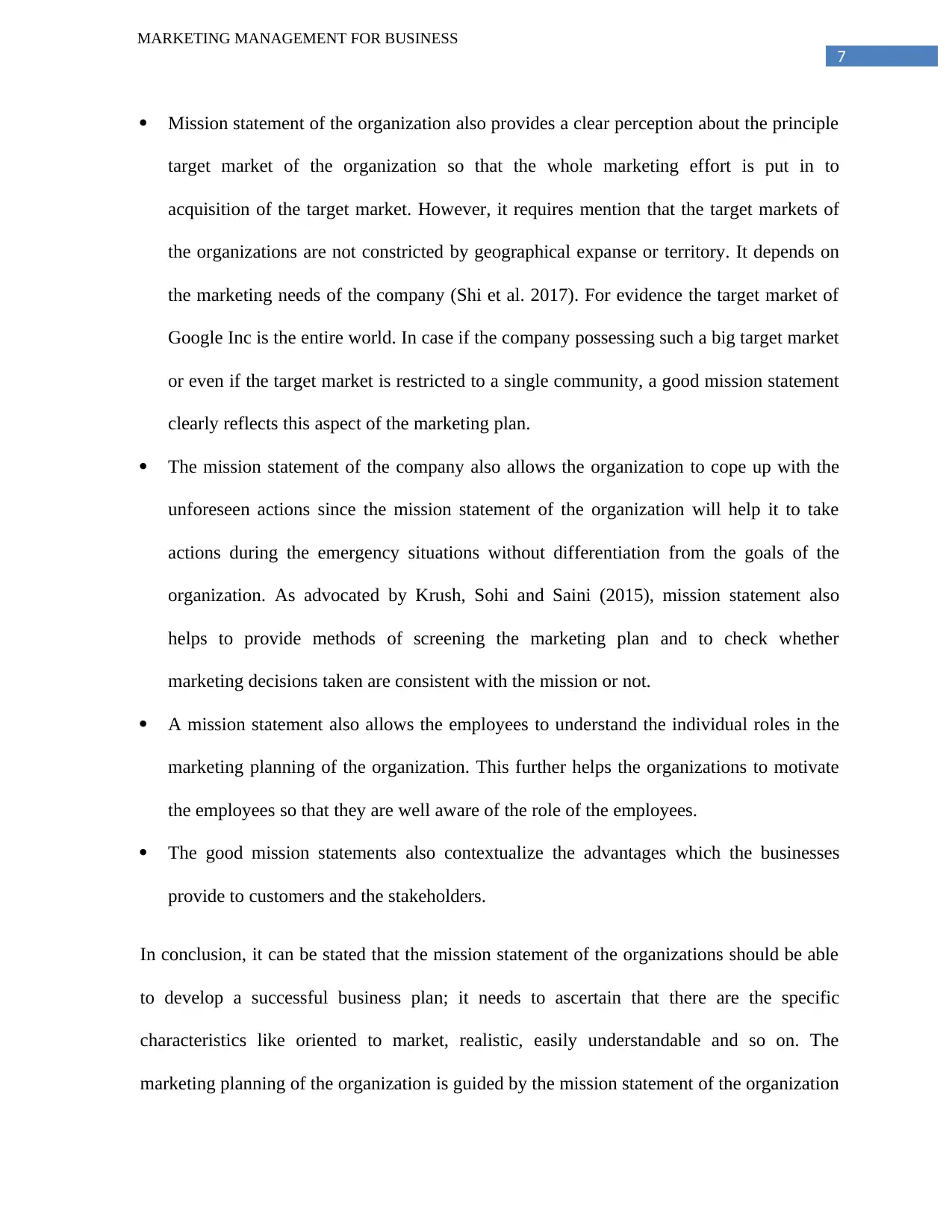
7
MARKETING MANAGEMENT FOR BUSINESS
Mission statement of the organization also provides a clear perception about the principle
target market of the organization so that the whole marketing effort is put in to
acquisition of the target market. However, it requires mention that the target markets of
the organizations are not constricted by geographical expanse or territory. It depends on
the marketing needs of the company (Shi et al. 2017). For evidence the target market of
Google Inc is the entire world. In case if the company possessing such a big target market
or even if the target market is restricted to a single community, a good mission statement
clearly reflects this aspect of the marketing plan.
The mission statement of the company also allows the organization to cope up with the
unforeseen actions since the mission statement of the organization will help it to take
actions during the emergency situations without differentiation from the goals of the
organization. As advocated by Krush, Sohi and Saini (2015), mission statement also
helps to provide methods of screening the marketing plan and to check whether
marketing decisions taken are consistent with the mission or not.
A mission statement also allows the employees to understand the individual roles in the
marketing planning of the organization. This further helps the organizations to motivate
the employees so that they are well aware of the role of the employees.
The good mission statements also contextualize the advantages which the businesses
provide to customers and the stakeholders.
In conclusion, it can be stated that the mission statement of the organizations should be able
to develop a successful business plan; it needs to ascertain that there are the specific
characteristics like oriented to market, realistic, easily understandable and so on. The
marketing planning of the organization is guided by the mission statement of the organization
MARKETING MANAGEMENT FOR BUSINESS
Mission statement of the organization also provides a clear perception about the principle
target market of the organization so that the whole marketing effort is put in to
acquisition of the target market. However, it requires mention that the target markets of
the organizations are not constricted by geographical expanse or territory. It depends on
the marketing needs of the company (Shi et al. 2017). For evidence the target market of
Google Inc is the entire world. In case if the company possessing such a big target market
or even if the target market is restricted to a single community, a good mission statement
clearly reflects this aspect of the marketing plan.
The mission statement of the company also allows the organization to cope up with the
unforeseen actions since the mission statement of the organization will help it to take
actions during the emergency situations without differentiation from the goals of the
organization. As advocated by Krush, Sohi and Saini (2015), mission statement also
helps to provide methods of screening the marketing plan and to check whether
marketing decisions taken are consistent with the mission or not.
A mission statement also allows the employees to understand the individual roles in the
marketing planning of the organization. This further helps the organizations to motivate
the employees so that they are well aware of the role of the employees.
The good mission statements also contextualize the advantages which the businesses
provide to customers and the stakeholders.
In conclusion, it can be stated that the mission statement of the organizations should be able
to develop a successful business plan; it needs to ascertain that there are the specific
characteristics like oriented to market, realistic, easily understandable and so on. The
marketing planning of the organization is guided by the mission statement of the organization
Paraphrase This Document
Need a fresh take? Get an instant paraphrase of this document with our AI Paraphraser
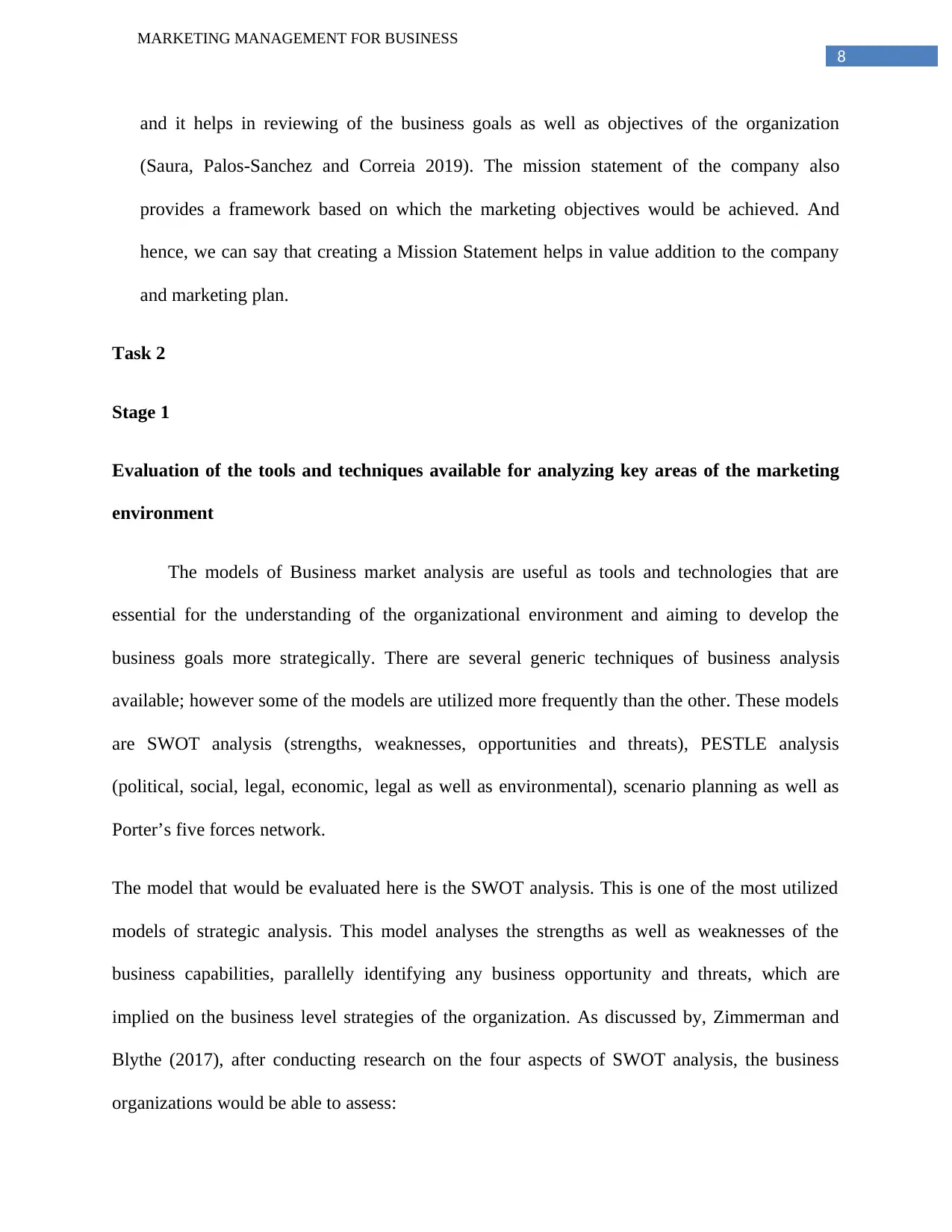
8
MARKETING MANAGEMENT FOR BUSINESS
and it helps in reviewing of the business goals as well as objectives of the organization
(Saura, Palos-Sanchez and Correia 2019). The mission statement of the company also
provides a framework based on which the marketing objectives would be achieved. And
hence, we can say that creating a Mission Statement helps in value addition to the company
and marketing plan.
Task 2
Stage 1
Evaluation of the tools and techniques available for analyzing key areas of the marketing
environment
The models of Business market analysis are useful as tools and technologies that are
essential for the understanding of the organizational environment and aiming to develop the
business goals more strategically. There are several generic techniques of business analysis
available; however some of the models are utilized more frequently than the other. These models
are SWOT analysis (strengths, weaknesses, opportunities and threats), PESTLE analysis
(political, social, legal, economic, legal as well as environmental), scenario planning as well as
Porter’s five forces network.
The model that would be evaluated here is the SWOT analysis. This is one of the most utilized
models of strategic analysis. This model analyses the strengths as well as weaknesses of the
business capabilities, parallelly identifying any business opportunity and threats, which are
implied on the business level strategies of the organization. As discussed by, Zimmerman and
Blythe (2017), after conducting research on the four aspects of SWOT analysis, the business
organizations would be able to assess:
MARKETING MANAGEMENT FOR BUSINESS
and it helps in reviewing of the business goals as well as objectives of the organization
(Saura, Palos-Sanchez and Correia 2019). The mission statement of the company also
provides a framework based on which the marketing objectives would be achieved. And
hence, we can say that creating a Mission Statement helps in value addition to the company
and marketing plan.
Task 2
Stage 1
Evaluation of the tools and techniques available for analyzing key areas of the marketing
environment
The models of Business market analysis are useful as tools and technologies that are
essential for the understanding of the organizational environment and aiming to develop the
business goals more strategically. There are several generic techniques of business analysis
available; however some of the models are utilized more frequently than the other. These models
are SWOT analysis (strengths, weaknesses, opportunities and threats), PESTLE analysis
(political, social, legal, economic, legal as well as environmental), scenario planning as well as
Porter’s five forces network.
The model that would be evaluated here is the SWOT analysis. This is one of the most utilized
models of strategic analysis. This model analyses the strengths as well as weaknesses of the
business capabilities, parallelly identifying any business opportunity and threats, which are
implied on the business level strategies of the organization. As discussed by, Zimmerman and
Blythe (2017), after conducting research on the four aspects of SWOT analysis, the business
organizations would be able to assess:

9
MARKETING MANAGEMENT FOR BUSINESS
i) Understand the direction in which the business strategies can be formulated so that the
strengths of business can be best utilized.
ii) Reduce the impact of the weaknesses on the business outcomes by implementing change
management strategies.
iii) Utilize the opportunities and to create more avenues for aggravated profit.
iv) Understand the areas of threat and develop the business potential so that the factors of threat
can be reduced in the future.
However, it deserves mention that the SWOT analysis considers only the internal aspects of
business. The implications of the external factors on the business are not understood in depth as
an outcome of undergoing SWOT analysis.
The tool which is most adapted for the analysis of the external factors affecting the
business ventures of the organization is PESTLE analysis. This is a framework that marketers
mostly use for the analysis, evaluation and monitoring of the micro environmental factors that
affect the industry. The outcomes of PESTLE analysis is used for the analysis of the factors of
strengths and weaknesses under SWOT analysis. Under PESTLE framework, a business
organization analyses the political, social, environmental, legal, technological as well as the
economic factors affecting the business of an organization and the industry where the
organization operates (Aithal 2016). Hence it can be concluded here that the PESTLE analysis is
to be conducted by any organization before stepping in to any specific business genre or entering
any new market segment. In case of an existing business, the PESTLE analysis provides the
business with an idea of the impact that the criteria of the individual factors of PESTLE have on
the business, if the company needs to abide by any new legal and/or political standards that the
MARKETING MANAGEMENT FOR BUSINESS
i) Understand the direction in which the business strategies can be formulated so that the
strengths of business can be best utilized.
ii) Reduce the impact of the weaknesses on the business outcomes by implementing change
management strategies.
iii) Utilize the opportunities and to create more avenues for aggravated profit.
iv) Understand the areas of threat and develop the business potential so that the factors of threat
can be reduced in the future.
However, it deserves mention that the SWOT analysis considers only the internal aspects of
business. The implications of the external factors on the business are not understood in depth as
an outcome of undergoing SWOT analysis.
The tool which is most adapted for the analysis of the external factors affecting the
business ventures of the organization is PESTLE analysis. This is a framework that marketers
mostly use for the analysis, evaluation and monitoring of the micro environmental factors that
affect the industry. The outcomes of PESTLE analysis is used for the analysis of the factors of
strengths and weaknesses under SWOT analysis. Under PESTLE framework, a business
organization analyses the political, social, environmental, legal, technological as well as the
economic factors affecting the business of an organization and the industry where the
organization operates (Aithal 2016). Hence it can be concluded here that the PESTLE analysis is
to be conducted by any organization before stepping in to any specific business genre or entering
any new market segment. In case of an existing business, the PESTLE analysis provides the
business with an idea of the impact that the criteria of the individual factors of PESTLE have on
the business, if the company needs to abide by any new legal and/or political standards that the
⊘ This is a preview!⊘
Do you want full access?
Subscribe today to unlock all pages.

Trusted by 1+ million students worldwide
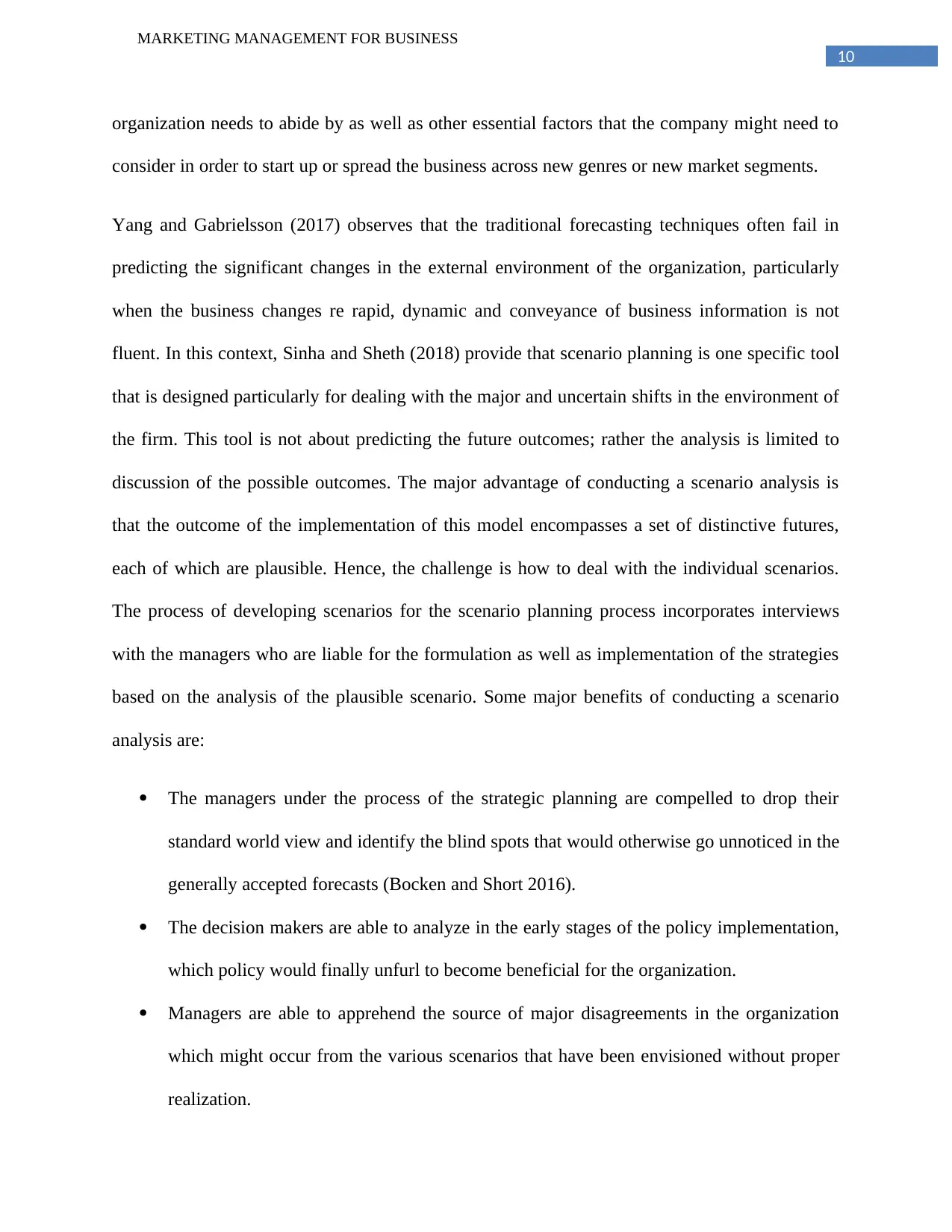
10
MARKETING MANAGEMENT FOR BUSINESS
organization needs to abide by as well as other essential factors that the company might need to
consider in order to start up or spread the business across new genres or new market segments.
Yang and Gabrielsson (2017) observes that the traditional forecasting techniques often fail in
predicting the significant changes in the external environment of the organization, particularly
when the business changes re rapid, dynamic and conveyance of business information is not
fluent. In this context, Sinha and Sheth (2018) provide that scenario planning is one specific tool
that is designed particularly for dealing with the major and uncertain shifts in the environment of
the firm. This tool is not about predicting the future outcomes; rather the analysis is limited to
discussion of the possible outcomes. The major advantage of conducting a scenario analysis is
that the outcome of the implementation of this model encompasses a set of distinctive futures,
each of which are plausible. Hence, the challenge is how to deal with the individual scenarios.
The process of developing scenarios for the scenario planning process incorporates interviews
with the managers who are liable for the formulation as well as implementation of the strategies
based on the analysis of the plausible scenario. Some major benefits of conducting a scenario
analysis are:
The managers under the process of the strategic planning are compelled to drop their
standard world view and identify the blind spots that would otherwise go unnoticed in the
generally accepted forecasts (Bocken and Short 2016).
The decision makers are able to analyze in the early stages of the policy implementation,
which policy would finally unfurl to become beneficial for the organization.
Managers are able to apprehend the source of major disagreements in the organization
which might occur from the various scenarios that have been envisioned without proper
realization.
MARKETING MANAGEMENT FOR BUSINESS
organization needs to abide by as well as other essential factors that the company might need to
consider in order to start up or spread the business across new genres or new market segments.
Yang and Gabrielsson (2017) observes that the traditional forecasting techniques often fail in
predicting the significant changes in the external environment of the organization, particularly
when the business changes re rapid, dynamic and conveyance of business information is not
fluent. In this context, Sinha and Sheth (2018) provide that scenario planning is one specific tool
that is designed particularly for dealing with the major and uncertain shifts in the environment of
the firm. This tool is not about predicting the future outcomes; rather the analysis is limited to
discussion of the possible outcomes. The major advantage of conducting a scenario analysis is
that the outcome of the implementation of this model encompasses a set of distinctive futures,
each of which are plausible. Hence, the challenge is how to deal with the individual scenarios.
The process of developing scenarios for the scenario planning process incorporates interviews
with the managers who are liable for the formulation as well as implementation of the strategies
based on the analysis of the plausible scenario. Some major benefits of conducting a scenario
analysis are:
The managers under the process of the strategic planning are compelled to drop their
standard world view and identify the blind spots that would otherwise go unnoticed in the
generally accepted forecasts (Bocken and Short 2016).
The decision makers are able to analyze in the early stages of the policy implementation,
which policy would finally unfurl to become beneficial for the organization.
Managers are able to apprehend the source of major disagreements in the organization
which might occur from the various scenarios that have been envisioned without proper
realization.
Paraphrase This Document
Need a fresh take? Get an instant paraphrase of this document with our AI Paraphraser
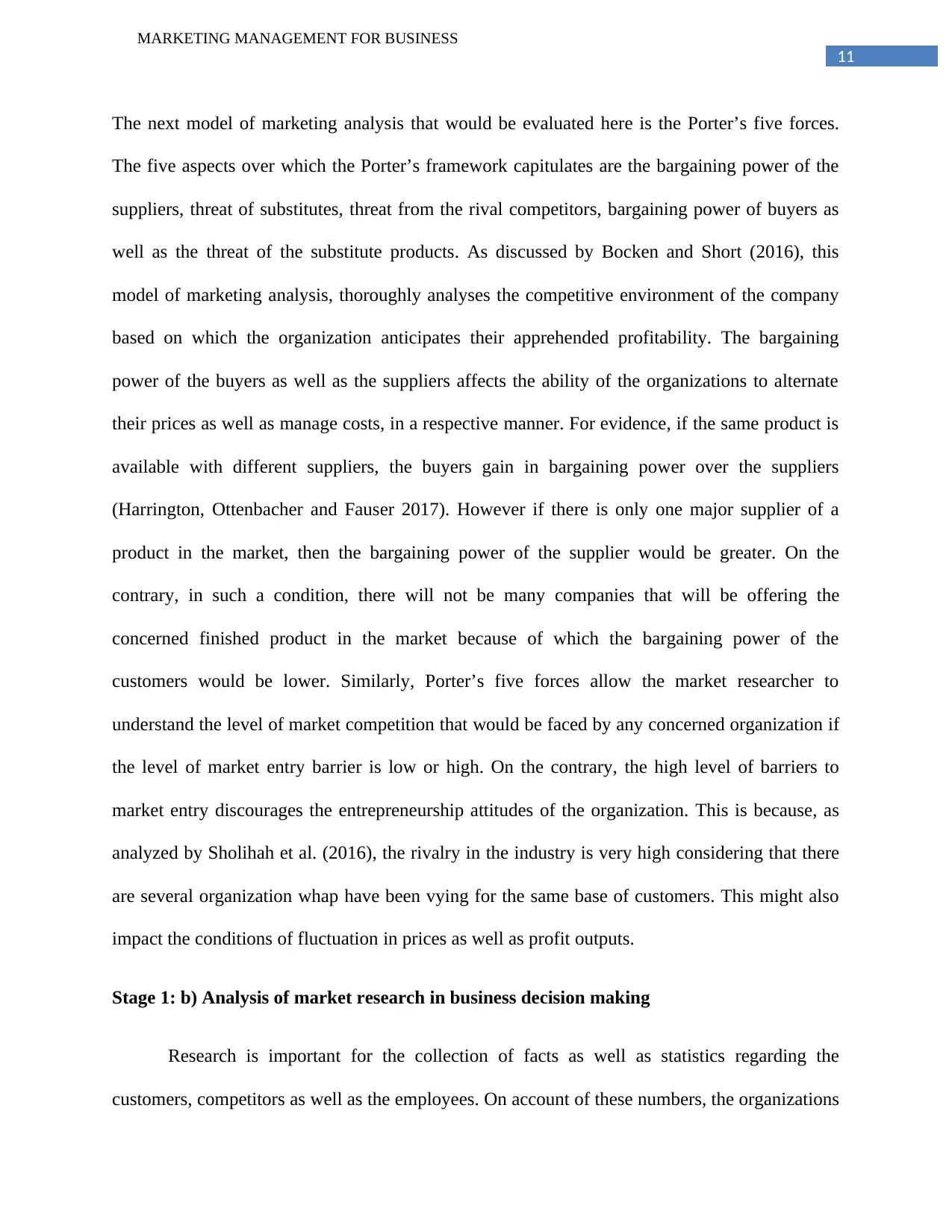
11
MARKETING MANAGEMENT FOR BUSINESS
The next model of marketing analysis that would be evaluated here is the Porter’s five forces.
The five aspects over which the Porter’s framework capitulates are the bargaining power of the
suppliers, threat of substitutes, threat from the rival competitors, bargaining power of buyers as
well as the threat of the substitute products. As discussed by Bocken and Short (2016), this
model of marketing analysis, thoroughly analyses the competitive environment of the company
based on which the organization anticipates their apprehended profitability. The bargaining
power of the buyers as well as the suppliers affects the ability of the organizations to alternate
their prices as well as manage costs, in a respective manner. For evidence, if the same product is
available with different suppliers, the buyers gain in bargaining power over the suppliers
(Harrington, Ottenbacher and Fauser 2017). However if there is only one major supplier of a
product in the market, then the bargaining power of the supplier would be greater. On the
contrary, in such a condition, there will not be many companies that will be offering the
concerned finished product in the market because of which the bargaining power of the
customers would be lower. Similarly, Porter’s five forces allow the market researcher to
understand the level of market competition that would be faced by any concerned organization if
the level of market entry barrier is low or high. On the contrary, the high level of barriers to
market entry discourages the entrepreneurship attitudes of the organization. This is because, as
analyzed by Sholihah et al. (2016), the rivalry in the industry is very high considering that there
are several organization whap have been vying for the same base of customers. This might also
impact the conditions of fluctuation in prices as well as profit outputs.
Stage 1: b) Analysis of market research in business decision making
Research is important for the collection of facts as well as statistics regarding the
customers, competitors as well as the employees. On account of these numbers, the organizations
MARKETING MANAGEMENT FOR BUSINESS
The next model of marketing analysis that would be evaluated here is the Porter’s five forces.
The five aspects over which the Porter’s framework capitulates are the bargaining power of the
suppliers, threat of substitutes, threat from the rival competitors, bargaining power of buyers as
well as the threat of the substitute products. As discussed by Bocken and Short (2016), this
model of marketing analysis, thoroughly analyses the competitive environment of the company
based on which the organization anticipates their apprehended profitability. The bargaining
power of the buyers as well as the suppliers affects the ability of the organizations to alternate
their prices as well as manage costs, in a respective manner. For evidence, if the same product is
available with different suppliers, the buyers gain in bargaining power over the suppliers
(Harrington, Ottenbacher and Fauser 2017). However if there is only one major supplier of a
product in the market, then the bargaining power of the supplier would be greater. On the
contrary, in such a condition, there will not be many companies that will be offering the
concerned finished product in the market because of which the bargaining power of the
customers would be lower. Similarly, Porter’s five forces allow the market researcher to
understand the level of market competition that would be faced by any concerned organization if
the level of market entry barrier is low or high. On the contrary, the high level of barriers to
market entry discourages the entrepreneurship attitudes of the organization. This is because, as
analyzed by Sholihah et al. (2016), the rivalry in the industry is very high considering that there
are several organization whap have been vying for the same base of customers. This might also
impact the conditions of fluctuation in prices as well as profit outputs.
Stage 1: b) Analysis of market research in business decision making
Research is important for the collection of facts as well as statistics regarding the
customers, competitors as well as the employees. On account of these numbers, the organizations

12
MARKETING MANAGEMENT FOR BUSINESS
are able to undertake better management decisions. The accumulated data of the research is
supposed to be organized in format of report and the managerial committees of the organization
use these findings in order to implement new business decisions. In this context, Penumarti et al.
(2017), opines that a proper research mechanism is very essential, irrespective of the expanse of
the form and the broadness of the client base.
i) Significance of Research
The organization is capable of making knowledgeable decisions base on the outcomes of
research process. In the business research process, the organization is able to accumulate
information regarding the primary business areas, analyze the collected data and thereupon
develop a strategy as well as distribute business details. In this context, Li, Liu and Huan (2019),
analyses that the report that is presented to the top management at the end , incorporates
information regarding the consumer as well as employee preferences as well as all available
routes for sales, finance, marketing as well as production. These business data is utilized by the
management in order to formulate the best business strategy. In this context, Gupta, Nagpal and
Malik (2018), opines that research is a prerequisite in all the layers of the business related
operations.
ii) Functions
By undertaking the business research, the company anticipates the demands of the
customers, and thereupon formulates strategies for developing the product which can meet the
demands of the potential customer groups. Market research is also essential for the determination
of the level of market acceptance of a certain product. However, Segabinazzi et al. (2016),
MARKETING MANAGEMENT FOR BUSINESS
are able to undertake better management decisions. The accumulated data of the research is
supposed to be organized in format of report and the managerial committees of the organization
use these findings in order to implement new business decisions. In this context, Penumarti et al.
(2017), opines that a proper research mechanism is very essential, irrespective of the expanse of
the form and the broadness of the client base.
i) Significance of Research
The organization is capable of making knowledgeable decisions base on the outcomes of
research process. In the business research process, the organization is able to accumulate
information regarding the primary business areas, analyze the collected data and thereupon
develop a strategy as well as distribute business details. In this context, Li, Liu and Huan (2019),
analyses that the report that is presented to the top management at the end , incorporates
information regarding the consumer as well as employee preferences as well as all available
routes for sales, finance, marketing as well as production. These business data is utilized by the
management in order to formulate the best business strategy. In this context, Gupta, Nagpal and
Malik (2018), opines that research is a prerequisite in all the layers of the business related
operations.
ii) Functions
By undertaking the business research, the company anticipates the demands of the
customers, and thereupon formulates strategies for developing the product which can meet the
demands of the potential customer groups. Market research is also essential for the determination
of the level of market acceptance of a certain product. However, Segabinazzi et al. (2016),
⊘ This is a preview!⊘
Do you want full access?
Subscribe today to unlock all pages.

Trusted by 1+ million students worldwide
1 out of 32
Related Documents
Your All-in-One AI-Powered Toolkit for Academic Success.
+13062052269
info@desklib.com
Available 24*7 on WhatsApp / Email
![[object Object]](/_next/static/media/star-bottom.7253800d.svg)
Unlock your academic potential
Copyright © 2020–2025 A2Z Services. All Rights Reserved. Developed and managed by ZUCOL.



